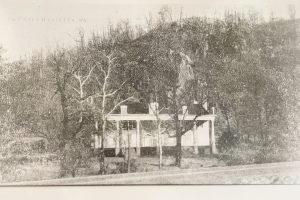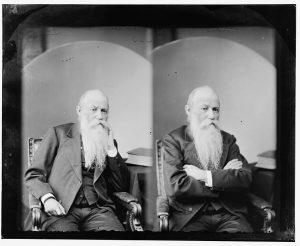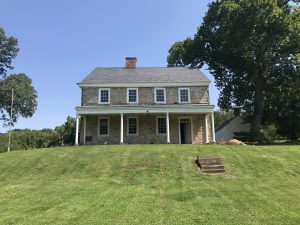RiverRoots: “The Sage of Chiques”
RiverRoots: “The Sage of Chiques”
River Roots is Susquehanna NHA’s blog series featuring history from York and Lancaster Counties that showcases the Susquehanna River’s historical, cultural, and natural resource contributions to our nation’s heritage.
Susquehanna NHA is pleased to introduce guest blog writers, Jean-Paul Benowitz, Director of Public Heritage Studies at Elizabethtown College, and Eric Schubert public historian and genealogist.
Read the original research paper here.
RiverRoots Heritage Blog
Have you ever seen a sign reading “Historic Haldeman Mansion” along Pennsylvania State Route 441 in Bainbridge? Did you know, that in the nineteenth century, an internationally renowned scientist and philologist lived along the banks of the Susquehanna? Samuel Haldeman was dubbed the “Sage of Chiques” for his expansive knowledge and publications on science, history, and languages.
Locust Grove and the Haldeman Homestead
In 1784, Samuel’s grandfather, John Haldeman acquired land in Conoy Township. He called the Haldeman family estate Locust Grove. John inherited the Haldeman Homestead farm from his father-in-law. The property included a house, stone kitchen, smokehouse, barn, mill, still house, and sawmill. The home, now Haldeman Mansion, was originally a 1730s German vernacular house. In 1811, John and his wife, Maria Brennerman Haldeman, expanded the house into a mansion and remodeled it in the Federalist style. John also built a grist mill and distillery at the mouth of the Conoy Creek.
In 1804, John’s oldest son, John Brenneman Haldeman, moved to Locust Grove Estate to manage the sawmill, gristmill, and distillery. Later, John Brenneman Haldeman returned to the Haldeman Family Homestead to manage the farm. His brother, Henry Haldeman, took charge of the industries at Locust Grove.
Samuel Haldeman: Early Education
Samuel Stehman Haldeman was born at Locust Grove on August 12, 1812, to Henry and Frances Stehman Haldeman. As a child, Samuel read extensively from books in his father’s library. He taught himself about natural history by collecting specimens of shells, insects, birds, and minerals. Samuel learned how to observe and stuff birds and mammals from a traveling Methodist minister. He collected the skeletons of rabbits, opossums, muskrats, and field mice as natural history specimens.
The Locust Grove property was part of a Native American village site dating back to 1200. Samuel made archaeological digs at Locust Grove and collected artifacts from Shenks Ferry, Susquehannock, and Conoy people. After Samuel’s death, the National Register of Historic Places and the Historic Preservation Trust of Lancaster County recognized the Haldeman Mansion for important Native American artifacts found there.
Samuel attended Dr. John Miller Keagy’s Classical Academy in Harrisburg at fourteen. The school is now called Harrisburg Academy. Two years later, Samuel enrolled with the class of 1831 at Dickinson College in Carlisle. For two years, he studied there under the geologist Henry Darwin Rogers.
Iron Industry
In 1828, Samuel’s father Henry bought several mills at the mouth of the Chikiswalungo (or Chiquesalunga) Creek in Marietta. In 1845, Henry and another son, Dr. Edwin Haldeman, established E. Haldeman and Company. They built an anthracite furnace west of Chickies Rock. Samuel and his brother Edwin managed the new enterprise. Samuel named the iron works company after the Native name of the nearby creek, meaning “place of the crabs,” hence Chikiswalungo Furnace. In 1858, when locals shortened the creek’s name, Samuel reluctantly approved changing the furnace’s name to Chickies Furnace.
Edwin, Paris, and Cyrus Summerfield Haldeman (Samuel’s brothers) eventually took over the business management. Samuel concerned himself with studying the scientific and technological aspects of iron smelting. In 1848, Samuel wrote two scholarly articles on the benefits of anthracite coal over traditional charcoal furnaces.

Personal Life
Despite being raised in the Anabaptist tradition of his Swiss German ancestors, Samuel converted to Roman Catholicism in the 1840s after studying comparative religions. Samuel belonged to St. Mary’s Church in Lancaster City and later St. Peter’s Church in Columbia. In 1869, Samuel raised funds for St Peter’s to build the Presentation of the Blessed Virgin Mary Church in Marietta.
In 1835, Samuel married Mary Ann Hough of Bainbridge and the couple had two sons and two daughters. After their wedding, Samuel and Mary moved to a new home in Marietta at the base of Chickies Rock. In 1833, Samuel designed the Greek Revival-style mansion and named it Rock Retreat. He filled the extensive gardens with native specimens of trees and shrubs.
Academic Achievements
From 1833–1834, Samuel attended natural history lectures in the Medical Department at the University of Pennsylvania. In 1835, Samuel wrote an article for the Lancaster Journal refuting the Great Moon Hoax, a sensational story claiming that there was life on the moon.
In 1836, Henry Darwin Rogers, Samuel’s former professor and Pennsylvania state geologist, put Samuel in charge of geology field operations in New Jersey. In 1837, Samuel returned to Pennsylvania to assist with Professor Roger’s state geology survey. Samuel personally surveyed Dauphin and Lancaster counties.

In 1840, Samuel returned to Rock Retreat, where he studied the natural history of invertebrates. He was especially interested in the taxonomy of beetles and freshwater mollusks. In 1842, Samuel established the Entomological Society of Pennsylvania. It was the first scientific society formed to study insects in America. Members of the society published hundreds of descriptions of American insects and gathered the first permanent insect collections in the country. In 1842, Samuel published his first entomological paper and became a Professor of Zoology at the Franklin Institute in Philadelphia. His lectures were the basis for many articles published in natural science journals.
In 1842, Samuel published his Monograph on the Freshwater Mollusca of the United States in the Conchological Section of the Academy of Natural Sciences. Samuel described Scolithus linearis as a trace fossil of some burrowing organism. It was the most ancient organic remains known at the time. Samuel was a member of the Academy of Natural Sciences in Philadelphia. In 1844, Samuel joined the American Philosophical Society. He was one of the founding members and served as its president from 1876-1877.
In 1844, Samuel wrote a paper on freshwater mollusks that defended Lamarckian evolution and transmutation of species. In 1848, U. S. Navy Rear Admiral Charles Wilkes asked Samuel to study the specimens discovered on his expedition of the Pacific Ocean.
Samuel’s eyesight began to deteriorate, but his hearing became remarkably sensitive. He discovered a new sound organ in Lepidopterous insects, which he described in Benjamin Silliman’s American Journal of Science. In 1848, Samuel published an article on his discovery of sound organs in certain moths. From 1851-1852, Samuel edited the Pennsylvania Farmer’s Journal.
Samuel chaired meetings about and wrote award-winning articles on English spelling reform. In 1875, Samuel joined a committee to review Noah Webster’s new spelling and determine necessary changes to the English language. Samuel contributed to Worchester’s Dictionary, the National Dictionary, and Johnson’s Cyclopedia. In 1868, Samuel became the first chair of the Department of Comparative Philology at The University of Pennsylvania.
Samuel was especially interested in the languages of Indigenous people in the U. S. and abroad. He traveled in America and internationally to study many languages. Samuel met visiting tribal delegations in Washington, D. C., and requested Indigenous vocabularies from Western naturalists. In 1849, Samuel established a reputation as an eminent philologist by presenting a paper at the American Association for the Advancement of Science and the American Academy of Arts and Sciences meetings.
Samuel introduced a new, more empirical approach to the study of languages. He studied Indian, Chinese, and English dialects. Samuel published scholarship on the Pennsylvania Dutch dialect. He even wrote the first Pennsylvania Dutch dictionary. During six trips abroad between 1847 and 1875, Samuel investigated multilingual areas in Europe. When studying the human voice in Rome, Samuel determined the vocal repertoire of 40–50 varieties of human speech. Samuel wrote widely on linguistic topics such as the pronunciation of Latin terms for naturalists, the relationship between Chinese and Indo-European languages, the origin and use of prefixes and suffixes in Pennsylvania Dutch, and a general outline of etymology.
Samuel was a Professor of Natural History at the University of Pennsylvania from 1851-1855. Samuel accepted a similar professorship at Delaware College (now the University of Delaware) while lecturing on geology and chemistry at the State Agricultural College of Pennsylvania (Now Pennsylvania State University). In 1851, Samuel visited Texas to explore the presidency of an academic institution there, but he declined the position. On his return trip from Texas, Samuel was offered the position of president of Masonic College in Selma, Alabama. He accepted and held the position from January to October 1852. That same year, he described the insects collected by Captain Howard Stansbury’s 1849 geographical survey of Utah’s Great Salt Lake.
In 1861, Charles Darwin wrote an acknowledgment of Samuel’s ideas supporting the theory of evolution in a preface to his, On the Origin of Species. Samuel authored 150 publications including important works on entomology, conchology, and philology; 120 were scientific and 30 were linguistic. Twenty-eight scientific societies worldwide gave Samuel honorary memberships.
Samuel was fascinated by exercise physiology. On one of his many trips to Paris, Samuel discovered a French gymnastic apparatus and studied the benefits of physical exercise. Samuel’s physician, his brother Edwin, prescribed outdoor exercise. Samuel, therefore, hiked Chiques Rock and did archeology fieldwork there. At Chiques Rock, Samuel discovered and excavated an Indigenous prehistoric settlement. In 1878, Samuel read a report before the American Philosophical Society, about his archaeological fieldwork at a prehistoric cave on his Rock Retreat property in Marietta. He published the report in 1881 as a monograph in the Transactions of the American Philosophical Society.
Samuel became known as the “Sage of Chiques.” Letters of inquiry from all over the world came across Samuel’s desk in Rock Retreat in Marietta. Publishers and editors asked for his opinions on and reviews of books. Writers and teachers inquired about pronunciation, spelling, and natural history facts. Naturalists forwarded packages of shells, insects, or minerals for identification, and farmers sent clays for analysis. Scientific journals and institutions sent invitations to lecture and requests for data.
On Friday, September 10, 1880, Samuel returned home to Rock Retreat from the American Association for the Advancement of Science meeting in Boston. That night, he had a heart attack and died at the desk in his study at age 68. Samuel was buried in the Haldeman family plot at the Marietta Cemetery on West Fairview Avenue in Marietta.
Remembering Marietta’s Internationally Renowned Scientist
In 1911, when the Haldeman iron business sold their property and demolished their furnaces, they also tore down Rock Retreat. In 2018, the East Donegal Rotary Club and Rivertownes PA USA erected a historical marker on the Northwest Lancaster County River Trail at the location of Samuel’s Greek Revival mansion.
In 1991, the Pennsylvania Historical and Museum Commission dedicated a Pennsylvania Historical Marker to Samuel. It is located along Pennsylvania State Route 441 north of the Locust Grove Estate. In 2018, the Pennsylvania Department of Environmental Protection recognized Samuel as one of forty-one men and women who shaped Pennsylvania’s environmental heritage.
Today the Haldeman Mansion is a public historic site administered by the Haldeman Mansion Preservation Society. In 1967, local historic preservationists formed the Haldeman Society to rehabilitate Locust Grove. In 1977, the Haldeman Mansion was placed on the Pennsylvania and National Register of Historic Places. It is number six on the inventory of historic buildings of the Historic Preservation Trust of Lancaster County.
When Samuel died, the Columbia landscape and portraiture artist Lloyd Mifflin, known as “America’s greatest sonneteer,” wrote these lines:
The Storm Clouds
In Memory of Samuel S. Haldeman, L. L. D.I stand beside the River as the night
Unrolls her sombre curtain o’er the day;
The pyres within the west have paled away
And only left their embers, dimly bright,
To illume the sullen hill-top’s purple height;
Then, from behind the crags, the clouds of gray-
A troop of lions held too long at bay-
Arise from out their antres in their might,
And low along the mountain ridges prowl,
Tossing their shaggy manes with lordly roar;
While, by the lash of lightning still uncowed,
They, raging and rebellious, long and loud,
Send many angry and deep-throated growl
Rumbling along the caverns of the shore!
Meet the Guest Writer Jean-Paul Benowitz
Jean-Paul Benowitz teaches history at Elizabethtown College where he is the Director of Public Heritage Studies. Since 1993 he has been on the faculty teaching in the Departments of History and Religious Studies. He earned his BS in History at Eastern Mennonite University where he wrote his senior thesis on the history of the Horse and Buggy Mennonites of Virginia. He earned his MA in History at Millersville University where he wrote his MA thesis on the history of the Horse and Buggy Mennonites of Pennsylvania and Virginia. He was a scholar in residence at Elizabethtown College’s Center for Anabaptist Studies. During this time, he authored several scholarly articles and books about Pennsylvania Dutch Culture. He teaches community-based learning Honors courses about local history and historic preservation; particularly related to the National Historic District of Marietta and the Chickies National Historic District. These courses have been recognized by the National Collegiate Honors Council where he serves on national committees for teaching and advising honors students and has authored monographs published by NCHC about teaching honors students. He has authored books about local history, articles about the Historic Peace Churches, and a column in the local newspaper in Elizabethtown about local history. Jean-Paul did his doctoral work at Temple University. His dissertation is a biography of U. S. Congressman James Wadsworth Symington who worked in the Eisenhower, Kennedy, and Johnson administrations. Much of Jean-Paul’s scholarship, published works, and public presentations have focused on 20th-century American political history, particularly presidential studies, and international relations. This has been the foundation for Honors courses he teaches about leadership in the Honors Program where he is an academic advisor and where he directs the Office of Prestigious Scholarships and Fellowships. Jean-Paul has been active in the Historic Harrisburg Association and Historic Preservation Trust of Lancaster County. The Historic Preservation Trust of Lancaster County presented Jean-Paul with the Smedley Award which is given to an educator who has shown extraordinary support for historic preservation in Lancaster County.
Meet the Guest Writer Eric Schubert
Eric Schubert, public historian, is an internationally recognized genealogist and forensic genetic genealogist with over ten years of research experience. A recent graduate of Elizabethtown College, he is a current History M.A. candidate at Millersville University. His journey helping individuals through genealogy began at the age of ten and has led to countless reunifications – as well as several solved cold cases. Features include People Magazine, The New York Times, The Washington Post, Good Morning America, and various other publications. His public history work throughout Lancaster County, often related to historic preservation and biography of the Marietta area, has been highlighted in Lancaster Online and Community Press. At Elizabethtown College Eric led a National Trust for Historic Preservation, This Place Matters Campaign, for the National Historic Districts of Marietta and Chickies, celebrating the role these places played, particularly Marietta Restoration Associates, Inc. in establishing a national historic preservation movement in the 1960s and especially in the aftermath of Hurricane Agnes 1972.
Sources
Ancestry.com, “Online Family Trees,” accessed March 12, 2024,
https://www.ancestry.com/search/collections/1030/
Barber, Edwin A.”The Late Professor S.S. Haldeman” The Museum; 1885. MG-344 S. S.
Haldeman Papers, Lancaster County Historical Society.
Biographical Annals of Lancaster County, Pa., Beers, 1903, pp. 144-5.
Brinton, D. G. “Memoir of S. S. Haldeman, A. M., Ph. D., etc.” Proceedings of the American
Philosophical Society. 1881, 19 (108): 279–285.
Croll, P. C. “Famous Pennsylvania Germans; Professor Samuel S. Haldeman, LL.D.” The
Pennsylvania German, v.6 1905.
Gramm, Bertha Sue. The Ironmasters of Marietta and Vicinity During the Period 1848-
1878, Lancaster County Historical Society: Lancaster, PA. 1948.
Haldeman, Horace L. “A Memoir of Prof. Samuel Steman Haldeman. LL. D.” Records of the
American Catholic Historical Society of Philadelphia. 1898, 9 (3): 257–292.
Hamersly, Lewis Randolph, ed. Who’s Who in Pennsylvania; Containing Authentic Biographies
of Pennsylvanians Who are Leaders and Representatives in Various Departments of
Worthy Human Achievement … New York: L. R. Hamersly Company, 1904.
Hart, Charles Henry. Memoir of Samuel Stehman Haldeman, LL.D., Professor of Comparative
Philology in the University of Pennsylvania, Philadelphia: Press of E. Stern & Co., 1881.
Lancaster County Historical Society, S. S. Haldeman Papers.
Landis, Hunt Maragret. “War of the Words, or Which Came First, Chiques or Chickes?” The
Journal of Lancaster County’s Historical Society, 2009, 111 (1): 12-27.
Malone, Dumas, ed. Dictionary of American Biography, New York: Charles Scribner’s Sons,
1932.
Men of Science and Industry: A Guide to the Biographies of Scientists, Engineers, Inventors and
Physicians, in the Carnegie Library of Pittsburgh, Pittsburgh: Carnegie Library, 1915.
Sorensen, W. Conner. “Haldeman, Samuel Stehman (1812-1880), Naturalist and Philologist,”
American National Biography, 1999.

